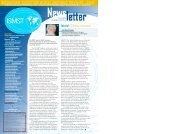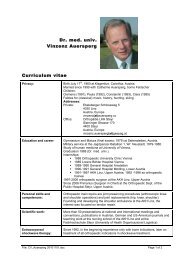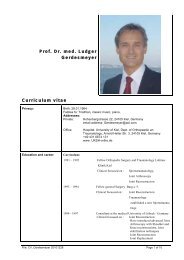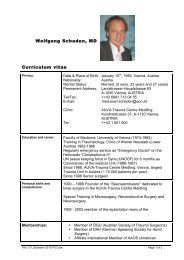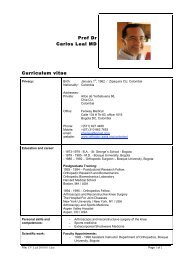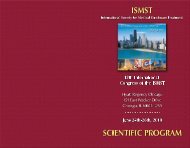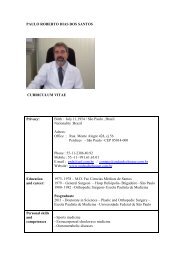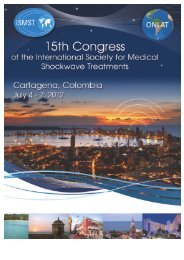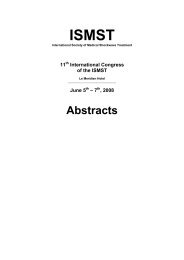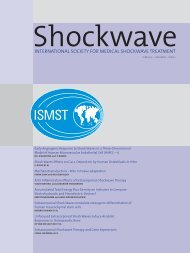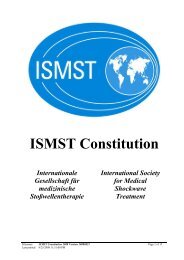Abstracts - ISMST - International Society for Medical Shockwave ...
Abstracts - ISMST - International Society for Medical Shockwave ...
Abstracts - ISMST - International Society for Medical Shockwave ...
You also want an ePaper? Increase the reach of your titles
YUMPU automatically turns print PDFs into web optimized ePapers that Google loves.
<strong>Abstracts</strong><br />
16. High Energy Shock Waves and 5-Aminolevulinic Acid <strong>for</strong> Sonodynamic Therapy:<br />
Effects on SK-N-BE and SH-SY5Y Neuroblastoma Cell Lines<br />
Roberto Frairia(1), Loredana Serpe(2), Roberto Canaparo(3), Gian Paolo Zara(3), Mario Eandi(3), Laura Berta(1)<br />
Institution:<br />
1 Dept. of Clinical Pathophysiology<br />
2 Dept. of Drug Science and Technology<br />
3 Dept. of Anatomy, Pharmacology and Forensic Medicine, University of Torino, School of Medicine, Torino, Italy<br />
Device and producing company: Piezoson 100, Richard Wolf<br />
Introduction: An appealing <strong>for</strong>m of treatment <strong>for</strong> solid tumors is sonodynamic therapy based on the ability of ultrasound to<br />
generate acoustic cavitation and to activate a tumor-localizing sonosensitizer agent (such as porphyrin compounds) like<br />
5-aminolevulinic acid (ALA). High Energy Shock Waves (HESW), generated by a piezoelectric device, are able to induce<br />
acoustic cavitation, which results in a concentration of energy sufficient to generate a sonoluminescent emission, which<br />
is able to cause electronic excitation of porphyrins by energy transfer and to initiate a photochemical process resulting<br />
in cytotoxic reactive oxygen species (ROS). For this reason, we have investigated the ability of HESW to activate ALA in<br />
human neuroblastoma SK-N-BE and SH-SY5Y cell lines.<br />
Methods: SK-N-BE and SH-SY5Y cells were exposed to ALA (50-300 µg/ml) <strong>for</strong> 24 h and then to HESWs (0.22-<br />
0.43 mJ/mm2; 500-1000 pulses): viable cell growth was determined at days 1, 3 and 7 after HESW treatment. Cell<br />
cytotoxicity was measured with WST-1 proliferation assay and cell death was evaluated by flow cytometric analysis. The<br />
relationship between sonodynamic treatment and production of ROS was evaluated by flow cytometric analysis with<br />
dichlorofluorescein diacetate. Furthermore, mRNA expression of different genes involved in apoptosis through ROS<br />
production was evaluated by quantitative SYBR Green real time RT-PCR, and fluorescence microscopic examination was<br />
carried out to highlight ROS production and cell death.<br />
Results: Sonodynamic treatment was able to induce a significant decrease in cell growth compared to untreated cells at 72<br />
h in both SK-N-BE and SH-SY5Y cells: up to 35% and 50%, respectively. Exposure of ALA pre-incubated cells to HESW<br />
significantly increased ROS production with different onset and extent in SK-N-BE and SH-SY5Y cells, and the apoptotic<br />
rate was significantly increased at 24 h in both cell lines.<br />
Discussion: We have identified different treatment schedules of ALA and HESW to produce the best cytotoxic rate in the<br />
two cell lines studied. These findings are in agreement with our previous reports, indicating that shock waves have a<br />
sudden effect in enhancing cytotoxic activities of compounds defined as sonosensitizers in different cell lines.<br />
Conclusion: Our results show that HESW are able to activate porphyrin compounds in neuroblastoma cell lines by acoustic<br />
cavitation obtaining significant in vitro cytotoxicity through ROS production.<br />
19



